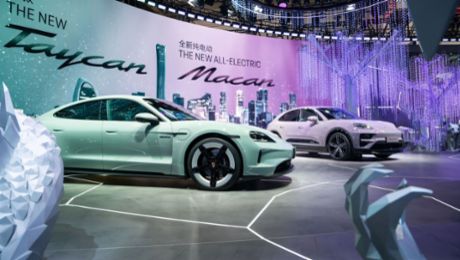718 Spyder RS: Fuel consumption* combined (WLTP) 13.0 l/100 km, CO₂ emissions* combined (WLTP) 294 g/km, CO2 class G
Mid-engined roadster with 59 kW (80 PS) more power.
With the new 718 Spyder RS, the entire 718 mid-engined model line is now available with the same 368 kW (500 PS) naturally aspirated boxer engine found in the 911 GT3 (911 GT3: Fuel consumption* combined (WLTP) 13.0 – 12.9 l/100 km, CO₂ emissions* combined (WLTP) 294 – 293 g/km, CO2 class G ) and the 911 GT3 Cup racing car. This makes the new 718 Spyder RS and its sister model, – the 718 Cayman GT4 RS (718 Cayman GT4 RS: Fuel consumption* combined (WLTP) 13.2 l/100 km, CO₂ emissions* combined (WLTP) 299 g/km, CO2 class G ), launched in 2022 – the most powerful offerings in the Porsche mid-engined family. Porsche is now entering the final straight for midengined sports cars with naturally aspirated engines, and as such the 718 Spyder RS stands as the crowning achievement of the model line in terms of open-topped driving pleasure.
The fastest soft-top 718 of all time.
With its impressive power output and standard short-ratio seven-speed PDK, the 718 Spyder RS goes from 0 to 100 km/h in just 3.4 seconds. The new 718 Spyder RS accelerates from a standstill to 200 km/h in just 10.9 seconds. The top speed is a blistering 308 km/h – without the roof.
Adjustable sports suspension.
The 718 Spyder RS comes as standard with a PASM sports suspension that can be lowered by 30 millimetres. The ride height, camber, track and anti-roll bars can all be adjusted individually. The tuning set-up is optimised for winding country roads and provides a more comfortable ride than the 718 Cayman GT4 RS. Standard: Porsche Torque Vectoring with mechanical limited-slip differential as well as ball-jointed suspension mounts and 20-inch forged aluminium wheels.
Ducktail instead of a rear wing.
In contrast to the 718 Cayman GT4 RS, the Spyder RS does not have a large rear wing, but rather a ducktail-style rear spoiler reminiscent of the legendary 911 Carrera RS 2.7 of 1972. The front end is largely identical to that of the 718 Cayman GT4 RS: with NACA ducts, side blades ahead of the front wheels, air vents on the wings and a wide air outlet in front of the carbon front luggage compartment cover. Only the front spoiler lip is somewhat less pronounced than in the GT4 RS. The process air intakes for an efficient combustion air supply to the engine of the Spyder RS are positioned between the roll-over bars and the rear wings on the rear lid.
Specially developed manually operated, lightweight roof.
The stripped-down and exceptionally lightweight soft-top roof of the Spyder RS consists of two individual parts: a canvas hood that protects occupants against the sun and a weather deflector with an integrated rear window. When both parts are installed, the car is rainproof. Leaving the roof at home in its entirety during consistently good weather saves an additional eight kilograms of weight.
Optional Weissach package.
The standard interior equipment includes lightweight CFRP full-bucket seats with leather side bolsters and Race-Tex centre sections. The dashboard and trims are upholstered in leather. There is also an optional Weissach package for the 718 Spyder RS, which additional Race-Tex features and numerous visible carbon-weave components. In addition, the optional, even lighter forged magnesium wheels can be ordered with the Weissach Package. The sports exhaust system tailpipes are made of titanium.


